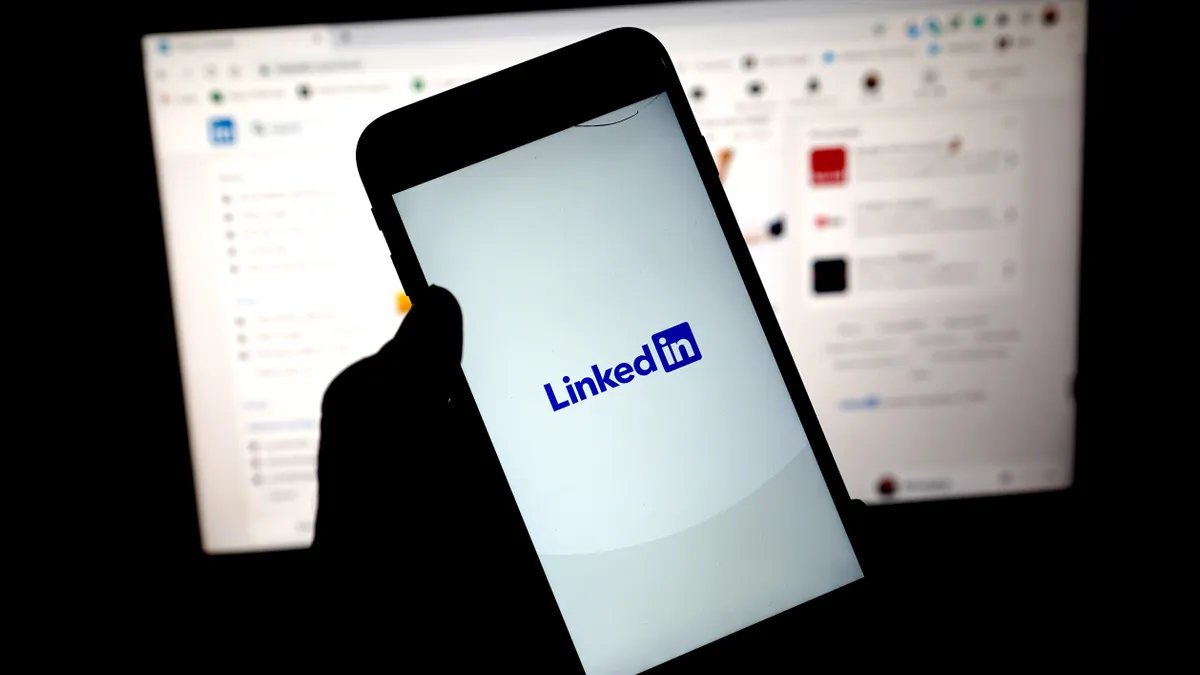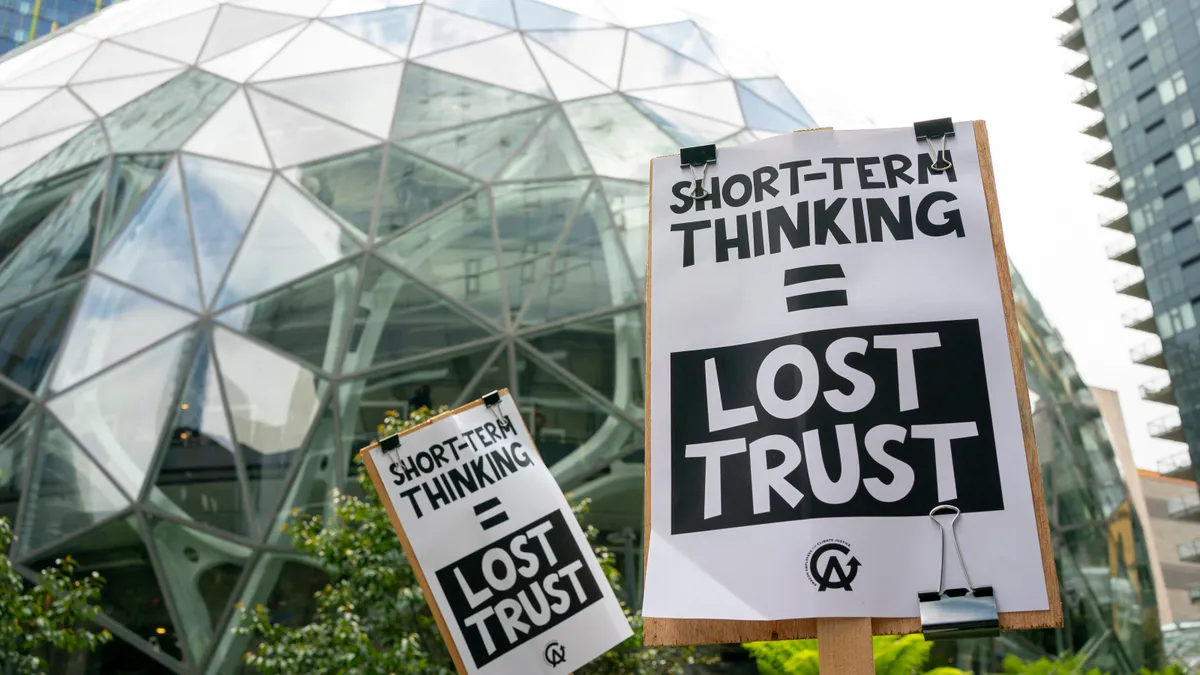Layoffs are never easy. But in some cases, leadership can do such a poor job of delivering the bad news that it attracts the attention of the wider public.
Mortgage lender Better.com is the latest such company to find itself a target. On Dec. 3, CEO Vishal Garg invited 900 employees to a six-minute Zoom meeting in which — with little fanfare or explanation — he told them the company was laying off a set of employees due to marketplace, performance and productivity. "If you're on this call you are part of the unlucky group that is being laid off," he told the workers. "Your employment here is terminated effective immediately."
Garg's approach to layoffs may have gotten him compared to the Grinch, but it also raised an important question for HR leaders and others: When you have to deliver bad news, what is the right way to do it? HR Dive talked to some experts on what leadership can do when they're about to give a lot of people a very bad day.
Consider the meeting size
Garg's first mistake, according to human motivation and engagement expert Hedda Bird, was calling a mass meeting. "All the documents say and all my experience shows that you need to give that kind of bad news preferably one to one, so one manager to the person who's going to be laid off, or at the very least, in small groups of two, three or four," she said.
With 900 people, such a task could seem overwhelming — but it's worth the time, Bird said. "You might say that he was trying to do that to save time and money," she said. "Obviously, with 900 people, if they're each going to have a one to one conversation … All the conversations are going to be short, but nonetheless, that's a lot of management time. And he might have thought, ‘Well, I'll save money. I'll just do it all in one fell swoop.' I should think he's now thinking that was not a way to save money."
If a company is in the unenviable position of having to lay off a large number of people, the head of people (or someone in a similar role) should prepare a brief, simple statement to send out to managers, Bird said, to prepare them to meet with staff one on one or in small groups to break the news. The CEO could send an all-staff email letting workers know that some of them would be receiving difficult news that day.
For the initial meeting, the length is less important, Bird explained; once people hear the bad news, "they won't hear anything else you say." Break the news, gently and with humanity, and then let them know to expect a follow-up shortly, whether that be a town hall meeting, a more in-depth conversation with a member of the HR team or something else.
Consider the timing
There's a reason Ebenezer Scrooge is a classic character of the holiday season: exhibiting cold corporate behavior near the holidays can send the message that profits trump people.
While there's no "good time" to lay off employees, "you don't do this weeks before Christmas," Rajeev Kapur, president and CEO of events and training company 1105 Media, told HR Dive. "He just raised $750 million from his investors a couple of weeks ago," he said. "Are you telling me that he couldn't wait till Jan. 3, 4, 5 or 6 to do this?"
It's unknown why Vishal chose the time he did to break the news, although there is unconfirmed speculation, both internally and externally, that the employee layoffs were a precondition of the $750 financing round Kapur referenced and that the timing was rushed. If an employer can help it, however, it should wait until January, Kapur said.
'Check your ego at the door'
One aspect of Garg's layoff address that drew criticism was his focus on himself. "This is the second time in my career I'm doing this and I do not — do not want to do this," Garg said in the video recording, which has been shared online. "The last time I did it, I cried. This time I hope to be stronger."
While it may be tempting to discuss one's own emotions as a way of trying to show empathy with those being laid off, the effect can be off-putting. "It's all about him and not about the people that he's talking to," Bird said.
Similarly, Kapur noted the "utter lack of gratitude" in the message. "One of the [things] I learned early on in my career is to check your ego at the door," he said. Employers may need to draw on a little bit of ego, but more pertinent to the job is the ability to exercise gratitude, empathy and accountability, Kapur said.
Following the layoffs, news of Garg's past behavior behavior trickled out as past employees spoke to the press and older articles resurfaced, including one in which Forbes obtained an email showing Vishal referred to his employees as "embarrassing" and "dumb dolphins."
Such tactics are not only mean and emotionally abusive, experts say — they are entirely unproductive. "If you're sitting at the top of the ladder of the business, you have two customers: the internal customer and the external customer," Kapur said. "You've got to make sure that you are taking care of your internal customers as much as, if not more than, your actual customer. Because if your internal customers are strong, happy, they're excited to come to work, excited to get up in the morning … they're gonna make your external customers happy. This is not a chicken or egg situation here."
Garg may have been letting go of the workers on the call, but about 90% of his other employees remained. Having seen their co-workers unceremoniously laid off and later slandered by Garg in a series of messages on anonymous workplace app Blind, some of those "internal customers" may be eyeing the door themselves.
Clear, transparent communication
One issue with the Better.com layoffs is that, for employees, it seemed to be a shock. Employers can do a better job of cushioning the blow by maintaining regular transparency about performance companywide and by division.
Ralf Specht, corporate value strategist and author of Building Corporate Soul, told HR Dive that Airbnb displayed this transparency when it was forced to lay off nearly one-quarter of the company in May 2020. "The memo starts, 'This is my seventh memo to all of you' — which suggests they had [received] six before, and all those six had looked at the challenges the pandemic provided to the hospitality industry overall," Specht said. (Airbnb CEO Brian Chesky was also transparent about the possibility of layoffs prior to the memo; "When you've asked me about layoffs, I've said that nothing is off the table," he wrote.)
Employees being laid off also need rapid transparency about support the company will provide, whether that applies to severance or other help from the HR staff. In a video, former Better.com employee Christian Chapman said none of those laid off had received an email detailing what would happen. They were left in limbo for "hours" after learning of the layoffs, with "no information," Chapman said.
The Airbnb memo, in comparison, laid out the the reason for the staff reduction decision, the process for determining who would be laid off and the support the company would provide to those who had to leave, including a minimum of 14 weeks' severance, dropping the one-year equity requirement so that all those leaving would be shareholders and 12 months' coverage of COBRA healthcare costs.
Kapur, who furloughed workers at the beginning of the pandemic, said he held town halls and staff meetings to explain in detail the reasoning behind the decision and outline the support the company would provide. "People … just want to be treated like adults and not children," he said. "[Garg] failed miserably at all of it."
Intervene earlier
While in many cases layoffs are due to external factors and cannot be avoided, Vishal blamed performance for "at least 250" of the layoffs in a series of messages, accusing those laid off employees of "stealing" from their co-workers. Vishal said he and his management team had pored over "individual employee productivity data," including "missed telephone call rates, number of inbound and outbound calls, employees showing up late to meetings with a customer and other factors," Fortune wrote in its review of the messages.
Assuming this information is accurate, Garg and the management team should have gotten involved long before layoffs were on the table, Kapur and Bird said.
"You talk to the teams," Kapur said. "‘Hey, guys, this is what we're seeing on our stats, we're seeing in our numbers … How can we fix this? What's the problem? Let's talk to the team. Is there something wrong here?'"
"If [Better.com] did actually have some employees who were not delivering, the general rule is to … intervene at the earliest possible moment, even if you think it is only a minor issue," Bird said. By simply checking in, it gives the employee an opportunity to explain and, in the case of an issue like needing child care, the opportunity for the employer to understand what might be interrupting their employees' workflow and what kind of benefits might be helpful to pursue in the future.
Just as importantly, checking in lets the employee know what is and isn't being noticed, so they can correct, if necessary, before it becomes a bigger issue. This kind of noticing can be done with a "very light touch," Bird said, framed with support rather than accusation. Further lagging performance can be dealt with in later conversations, if necessary, with an emphasis on support — but also transparency.
Having chosen a different path, Better.com is trying to manage the fallout from Garg's layoff decision and approach. Three top leaders have resigned. Garg followed up the meeting with an apology to the remaining employees, and he is currently taking time off.




















